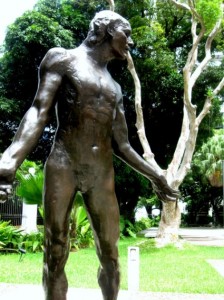
Photo © Michael Sommers.
When I first heard about the plans to open a Rodin museum in my adopted hometown of Salvador, the idea struck me as something straight out of a Gabriel Garcia Márquez novel. However, this was no piece of fiction and, in 2006, Brazil’s first Museu Rodin was inaugurated just a few blocks away from me in the leafy midst of the staid, old money, residential neighborhood of Graça.Ask not why Salvador needed a museum devoted to the works of France’s most celebrated sculptor, who had never set foot on Brazilian shores. Various arguments were put forward by Bahia’s Ministry of Culture; ranging from the necessity of dispelling the myth that Bahian culture was limited to local and Afro-centric manifestations to the incredible similarities between the Hotel de Biron, the hôtel particulier that houses Paris’ Musée Rodin, and the Palacete Vila Catharino, the eclectic style mansion, built in 1912 by a local aristocrat, which was chosen as the new museum’s site.
Once the go-ahead was given, the gracious mansion – with its ornate inlaid floors of precious Brazilian woods, jewel-hued stained glassed windows, and ornate wall and ceiling frescoes – was painstakingly restored while, behind it, an ultra-contemporary glass and concrete box rose up beneath the shade of the garden’s century-old mango trees.
It turned out that the project itself had cost so much money that when it came time to pay for the shipping, insurance, and security costs demanded by France’s Musée Rodin, the state coffers were dry. Millions of reais and a few behind-the-scenes scandals later, the Museu Rodin Bahia was inaugurated with much pomp at the tail end of 2006 – just in time for the Secretary of Culture to (very briefly) savor the concretization of his project and take his final bows before leaving office (in an unexpected political upheaval, the reigning party that had dominated state politics for over a quarter century had been voted out of power). Only one small detail marred the festivities: the Rodins hadn’t arrived!It turned out that the project itself had cost so much money that when it came time to pay for the shipping, insurance, and security costs demanded by France’s Musée Rodin, the state coffers were dry. In fact, it wasn’t until three years later, in 2009, that the Rodins finally arrived. By then, under the more democratic impulses of the PT (Worker’s Party) government, the museum had undergone a name change – to the more generic (and wordy) Palacete das Artes Rodin Bahia – and had already hosted an intriguing mishmash of temporary exhibitions, most of them showcasing works of modern and contemporary Bahian artists.
But back to the Rodins. Initially, the plan had been to purchase some authenticated copies of original works to supplement several sculptures already owned by the government (these official bronze replicas of famous works such as “The Martyr” are on permanent display in the beautiful gardens). However, in order to cut costs, a deal was subsequently made to “rent” a larger number of original works in plaster from the Musée Rodin.
The 62 works that arrived late last year – and were feted, if possible, with more pomp (and tons of champagne) – include versions of “The Kiss” and “The Walking Man” as well as numerous figures that eventually comprised one of Rodin’s most important works: “The Gates of Hell”, a monumental door peopled by figures inspired by Dante’s “Inferno” chapter of The Divine Comedy.
Having finally been arranged throughout the mansion’s rooms (to somewhat jarring effect), the works are currently on display until October 27, 2012. Although they don’t possess the polished impact of Rodin’s final sculptures in bronze and marble, even in the rough, a Rodin is a Rodin is a Rodin; it’s worth a few goose-bumps to see the master sculptor’s finger and hand prints etched into the plaster.
For those who have already seen plenty of Rodins in their day, and are looking for something a little more Brazilian, I highly recommend the temporary exhibition (on until June 8) devoted to one of Bahia’s most important contemporary artists, the photographer Mario Cravo Neto.
Housed in the modern gallery space behind the palacete, this exhibit is somewhat of an elegy to Cravo Neto who tragically died of cancer last year at the age of 62. On the surface, any similarities to Rodin would seem to be farfetched. However, Cravo Neto initiated his artistic life as a sculptor, and his photographs, most of them of human subjects, have a three-dimensional quality in which the body is palpable, sensual, and sculptural (although in a vital, flesh-and-blood manner).
The 33 black-and-white and color works combine poignant “semi-self portraits” with mystical and mysterious still lifes and renderings of close friends and family members. (Mario’s son Cristian Cravo – also a photographer – curated the exhibit and appears in a couple of the displayed photos). Imbuing many of the images with a lyrical sense of place are symbolic elements from the Afro-Brazilian Candomblé religion that is so strong in Bahia.
Have the patience to sit through the digital slideshow featuring over 100 photos from Cravo Neto’s book Laróyè! (2000). The ensemble offers a stunning snapshot panorama of Salvador, with riveting portraits of Bahians on the beach, at the market, sleeping on sidewalks, and getting down and dirty during Carnaval. Cravo Neto freezes the hot colors and deep textures of Salvador, but the way his lens seeks out and captures the expressiveness of both faces and bodies (many portraits are back shots) is arresting – and quite Rodin-like.
The Palacete das Artes Rodin Bahia is located at Rua da Graça, 292, Graça. Tel: (71)3117-6987. Opening hours are Tues-Sun, 10am-6pm. Admission is free. Regardless of the exhibitions, the mansion itself – one of Salvador’s few surviving grand turn-of-the-century residences – definitely merits a visit as do the surrounding gardens.